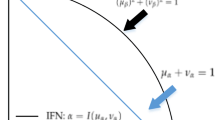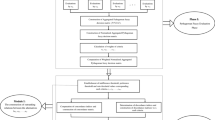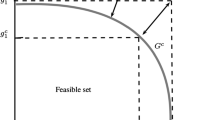Abstract
Due to insufficient information in multi-criteria decision-making (MCDM) problems, the decision values given by experts are often fuzzy and uncertain. As an extension of Pythagorean fuzzy set (PFS), interval-valued Pythagorean fuzzy (IPF) set is a more effective and powerful tool to handle fuzzy information in decision problems. But, there are two key issues that needed to be solved: weights of experts in the IPF environment and IPF aggregation operators. For these issues, a two-stage MCDM method is constructed in the IPF environment. In the first stage, a novel method for determining the weights of experts is proposed by introducing IPF set (IPFS) into social networks. To do that, the concepts of trust function (TF) and trust score (TS) in the IPF environment are defined to obtain the objective weights of experts. Meanwhile, the subjective weights of experts are obtained from the number of experts. Afterward, the objective weight and subjective weight of each expert are combined to derive the weight of each expert. In the second stage, a novel weighted sum model (WSM) with novel IPF aggregation operators is constructed to rank alternatives. Considering the psychological behavior of experts, that is, self-confidence level, four IPF aggregation operators with self-confidence levels are defined, namely, the self-confidence interval-valued Pythagorean fuzzy weighted averaging (SC-IPFWA) and ordered weighted averaging (SC-IPFOWA) operator, the self-confidence interval-valued Pythagorean fuzzy weighted geometric (SC-IPFWG) and ordered weighted geometric (SC-IPFOWG) operator. Finally, a numerical case is used to verify the effectiveness of the proposed two-stage MCDM method.


Similar content being viewed by others
References
Liu, P.D.; Zhang, L.L.; Wang, P.: Multi-valued neutrosophic number bonferroni mean operators with their applications in multiple attribute group decision making. Int. J. Inf. Tech. Decis. 15(5), 1181–1210 (2016)
Liao, H.C.; Xu, Z.S.; Xia, M.M.: Multiplicative consistency of hesitant fuzzy preference relation and its application in group decision making. Int. J. Inf. Tech. Decis. 13, 47–76 (2014)
Ji, Y.; Qu, S.J.; Wu, Z.; Liu, Z.M.: A Fuzzy-Robust Weighted Approach for Multicriteria Bilevel Games. IEEE Trans. Industr. Inf. 16(8), 5369–5376 (2020)
Attanassov, K.T.: Intuitionistic fuzzy sets. Fuzzy Set. Syst. 20, 87–96 (1986)
Attanassov, K.T.: More on intuitionistic fuzzy sets. Fuzzy Set. Syst. 33(1), 37–46 (1989)
Bellman, R.; Zadeh, L.: Decision making in a fuzzy environment. Manage. Sci. 17, 141–164 (1970)
Garg, H.; Singh, S.: Algorithm for solving group decision-making problems based on the similarity measures under type 2 intuitionistic fuzzy sets environment. Soft Comput. 24, 7361–7381 (2020)
Liu, P.D.; Wang, Y.M.; Jia, F.; Fujita, H.: A multiple attribute decision making three-way model for intuitionistic fuzzy numbers. Int. J. Approx. Reason. 19, 177–203 (2020)
Liu, B.S.; Zhou, Q.; Ding, R.X.; Ni, W.; Herrera, H.: Defective alternatives detection-based multi-attribute intuitionistic fuzzy large-scale decision making model. Knowl. Based Syst. (2019). https://doi.org/10.1016/j.knosys.2019.104962
Liu, P.D.; Gao, H.: Some intuitionistic fuzzy power Bonferroni mean operators in the framework of Dempster-Shafer theory and their application to multi-criteria decision making. Soft Comput (2019). https://doi.org/10.1016/j.asoc.2019.105790
Yager, R.R.: Pythagorean fuzzy subsets. In: Proceedings of the 2013 Joint IFSA World Congress and NAFIPS Annual Meeting ((IFSA/NAFIPS)). pp. 57–61 (2013)
Garg, H.: A novel accuracy function under interval-valued Pythagorean fuzzy environment for solving multi criteria decision making problem J. Intell. Fuzzy Syst. 31(1), 529–540 (2016)
Wu, J.; Chiclana, F.; Fujita, H., Herrera-Viedma, E.: A visual interaction consensus model for social network group decision making with trust propagation. Knowl. Based Syst. 122, 39–50 (2017)
Wu, J.; Chiclana, F.: A social network analysis trust consensus based approach to group decision-making problems with interval-valued fuzzy reciprocal preference relations. Knowl. Based Syst. 59, 97–107 (2014)
Liu, W.L.; Dong, Y.C.; Chiclana, F.; Cabrerizo, F.J.; Herrera-Viedma, E.: Group decision-making based on heterogeneous preference relations with self-confidence. Fuzzy Optim. Decis. Ma. 16, 429–447 (2017)
Garg, H.: Confidence levels based Pythagorean fuzzy aggregation operators and its application to decision-making process. Comput. Math. Organ. Theory 23, 546–571 (2017)
Garg, H.: New exponential operational laws and their aggregation operators for interval-valued Pythagorean fuzzy multi-criteria decision-making. Int. J. Intell. Syst. 33(3), 653–683 (2018)
Yang, W.; Pang, Y.F.: Hesitant interval-valued Pythagorean fuzzy VIKOR method. Int. J. Intell. Syst. 34(5), 754–789 (2019)
Wei, G.W.; Garg, H.; Gao, H.; Wei, C.: Interval-valued pythagorean fuzzy maclaurin symmetric mean operators in multiple attribute decision making. IEEE ACCESS. 6, 67866–67884 (2018)
Gao, H.; Wei, G.W.: Multiple attribute decision making based on interval-valued Pythagorean uncertain linguistic aggregation operators. Int. J. Know. Based Intell. Eng. Syst. 22(1), 59–81 (2018)
Liang, D.C.; Darko, A.P.; Zeng, J.: Interval-valued pythagorean fuzzy power average-based MULTIMOORA method for multi-criteria decision-making. J. Exp. Theor. Artif. In (2019). https://doi.org/10.1080/0952813X.2019.1694589
Yang, Y.; Chen, Z.S.; Chen, Y.H.; Chin, K.S.: Interval-valued pythagorean fuzzy frank power aggregation operators based on an isomorphic frank dual triple. Int. J. Comput. Int. Sys. 11(1), 1091–1110 (2018)
Wang, J.,;Wei, G.W.; Gao, H.: Approaches to multiple attribute decision making with interval-valued 2-tuple linguistic pythagorean fuzzy information. Mathematics (2018). https://doi.org/10.3390/math6100201
Rahman, K.; Abdullah, S.; Ghani, F.: Some new generalized interval-valued Pythagorean fuzzy aggregation operators using einstein t-norm and t-conorm. J. Intell. Fuzzy Syst. 37(3), 3721–3742 (2019)
Rahman, K.; Abdullah, S.; Ali, A.; Amin, F.: Interval-valued pythagorean fuzzy Einstein hybrid weighted averaging aggregation operator and their application to group decision making. Complex Intell. Syst. 5(1), 41–52 (2019)
Shakeel, M.; Abdullah, S.; Shahzad, M.; Fahmi, A.: Induced interval-valued Pythagorean trapezoidal fuzzy aggregation operators based on Einstein operations and their application in group decision making. J. Integr. Neurosci. 17(3–4), 633–659 (2018)
Du, Y.Q.; Hou, F.J.; Zafar, W., Yu, Q.; Zhai, Y.B.: A novel method for multi-attribute decision making with interval-valued pythagorean fuzzy linguistic information. Int. J. Intell. Syst. 32(10), 1085–1112 (2017)
Liang, D.C.; Darko, A.P.; Xu, Z.S.; Quan, W.: The linear assignment method for multi criteria group decision making based on interval-valued Pythagorean fuzzy Bonferroni mean. Int. J. Intell. Syst. 33(11), 2101–2138 (2018)
Liang, D.C.; Zhang, Y.R.J.; Xu, Z.S.; Darko, A.P.: Pythagorean fuzzy Bonferroni mean aggregation operator and its accelerative calculating algorithm with the multithreading. Int. J. Intell. Syst. 33(3), 615–633 (2018)
Tang, X.Y.; Wei, G.W.; Gao, H.: Models for Multiple attribute decision making with interval-valued pythagorean fuzzy muirhead mean operators and their application to green suppliers selection. Informatic. 30(1), 153–186 (2019)
Haktanir, E.; Kahraman, C.: A novel interval-valued pythagorean fuzzy QFD method and its application to solar photovoltaic technology development. Comput. Ind. Eng. 132, 361–372 (2019)
Ilbahar, E.; Kahraman, C.: Retail store performance measurement using a novel interval-valued Pythagorean fuzzy WASPAS method. J. Intell. Fuzzy Syst. 35(3), 3835–3846 (2018)
Liu, H.C.; Quan, M.Y.; Shi, H.; Guo, C.: An integrated MCDM method for robot selection under interval-valued Pythagorean uncertain linguistic environment. Int. J. Intell. Syst. 34(2), 188–214 (2019)
Xue, M.; Fu, C.; Yang, S.L.: Group consensus reaching based on a combination of expert weight and expert reliability. Appl. Math. Comput (2019). https://doi.org/10.1016/j.amc.2019.124902
Gupta, P.; Mehlawat, M.K.; Grover, N.: Intuitionistic fuzzy multi-attribute group decision-making with an application to plant location selection based on a new extended VIKOR method. Inform. Sci. 370, 184–203 (2016)
Dong, Y.C.; Zhang, H.J.; Herrera-Viedma, E.: Integrating experts' weights generated dynamically into the consensus reaching process and its applications in managing non-cooperative behaviors. Decis. Supp. Syst. 84, 1–15 (2016)
Wang, H.; Xu, C.; Xu, Z.S.: An approach to evaluate the methods of determining experts' objective weights based on evolutionary game theory. Knowl. Based Syst (2019). https://doi.org/10.1016/j.knosys.2019.07.033
Cheng, D.; Zhou, Z.L.; Cheng, F.X.; Wang, J.: Deriving heterogeneous experts’ weights from incomplete linguistic preference relations based on uninorm consistency. Knowl. Based Syst. 150, 150–165 (2018)
Zhang, X.L.; Xu, Z.S.: Deriving experts' weights based on consistency maximization in intuitionistic fuzzy group decision making. J. Intell. Fuzzy Syst. 27(1), 221–233 (2014)
Wu, T.; Zhang, K.; Liu, X.W.; Cao, C.Y.: A two-stage social trust network partition model for large-scale group decision-making problems. Knowl. Based Syst. 163, 632–643 (2019)
Liu, X.; Xu, Y.J.; Montes, R.; Herrera, F.: Social network group decision making: Managing self-confidence-based consensus model with the dynamic importance degree of experts and trust-based feedback mechanism. Inform. Sci. 505, 215–232 (2019)
Yue, C.: Projection-based approach to group decision-making with hybrid information representations and application to software quality evaluation. Comput. Ind. Eng (2019). https://doi.org/10.1016/j.cie.2019.04.012
Chen, L.Y.; Li, Z.; Deng, X.Y.: Emergency alternative evaluation under group decision makers: a new method based on entropy weight and DEMATEL. Int. J. Syst. Sci (2020). https://doi.org/10.1080/00207721.2020.1723731
Mishra, A.R.; Rani, P.; Pardasani, K.R.; Mardani, A.: A novel hesitant fuzzy WASPAS method for assessment of green supplier problem based on exponential information measures. J. Clean. Prod (2019). https://doi.org/10.1016/j.jclepro.2019.117901
Liu, X.; Qian, F.; Lin, L.N.; Zhang, K.; Zhu, L.B.: Intuitionistic fuzzy entropy for group decision making of water engineering project delivery system selection. Entropy (2019). https://doi.org/10.3390/e21111101
Fu, C.; Chang, W.J.; Liu, W.Y.; Yang, S.L.: Data-driven group decision making for diagnosis of thyroid nodule. Sci. China Inform. Sci (2019). https://doi.org/10.1007/s11432-019-9866-3
Shi, M.H.; Xiao, Y.W.; Wan, Q.: Extended Heronian mean based on hesitant fuzzy linguistic information for multiple attribute group decision-making. Complexity (2019). https://doi.org/10.1155/2019/1245353
Li, M.; Wang, D.M.; Shan, H.: Risk assessment of mine ignition sources using fuzzy Bayesian network. Process Saf. Environ. 125, 297–306 (2019)
Chourabi, Z.; Khedher, F.; Babay, A.; Cheikhrouhou, M.: Multi-criteria decision making in workforce choice using AHP. WSM WPM. J. Text. I. 110(7), 1092–1101 (2019)
Qu, S.J.; Zhou, Y.Y.; Zhang, Y.L.; Wahab, M.I.M.; Ye, Y.Y.; Zhang, G.: Optimal strategy for a green supply chain considering shipping policy and default risk. Comput. Ind. Eng. 131, 172–186 (2019)
Liu, Z.M.; Qu, S.J.; Goh, M.; Huang, R.P.; Wang, S.L.: Optimization of fuzzy demand distribution supply chain using modified sequence quadratic programming approach. J. Intell. Fuzzy Syst. 36, 6167–6180 (2019)
Liu, Z.; Li, K.W.; Li, B.Y.; Huang, J.; Tang, J.: Impact of product-design strategies on the operations of a closed-loop supply chain. Trans. Res. Part E: Logist. Trans. Rev. 124, 75–91 (2019)
Zheng, X.X.; Liu, Z.; Kevin, W.; Huang, J.; Chen, J.: Cooperative game approaches to coordinating a three-echelon closed-loop supply chain with fairness concerns. Int. J. Prod. Econ. 212, 92–110 (2019)
Acknowledgements
The work is supported by the National Fund Support Project on Social Science of China (No. 17GBL083). We are very grateful to the editors and referees for their careful reading and constructive suggestions on the manuscript.
Author information
Authors and Affiliations
Corresponding author
Rights and permissions
About this article
Cite this article
Ji, Y., Xu, Y., Qu, S. et al. A Novel Two-Stage Multi-Criteria Decision-Making Method Based on Interval-Valued Pythagorean Fuzzy Aggregation Operators with Self-Confidence Levels. Arab J Sci Eng 46, 1561–1584 (2021). https://doi.org/10.1007/s13369-020-04681-6
Received:
Accepted:
Published:
Issue Date:
DOI: https://doi.org/10.1007/s13369-020-04681-6




